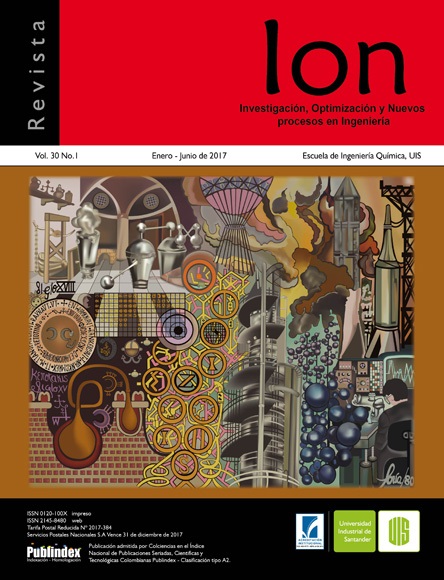Effect of carbonate chemical speciation on crevice corrosion of nickel superalloy
Published 2017-06-30
Keywords
- Alloy 22,
- Crevice corrosion,
- carbonate chemical speciation,
- cloruros,
- repassivation potential
- PD-GS-PD ...More
How to Cite

This work is licensed under a Creative Commons Attribution 4.0 International License.
Abstract
The inhibitory effects of carbonate chemical species on the susceptibility of crevice corrosion of the alloy 22 in chloride solutions were studied. In this work electrochemical techniques such as Anodic Polarizations Curves and Potentiodynamic-Galvanostatic-Potentiodynamic (PD-GS-PD), Electrochemical Impedance Spectroscopy and Scanning Electron Microscopy (SEM) were applied to determine the passive behavior of the alloy in the presence of these species. Results indicated that carbonic acid and bicarbonate not showed inhibitory effects on the conditions studied. Carbonate presented a critical molar ratio R =[CO=3]/[Cl-] = 1 independent of the chloride concentration. The presence of an anodic peak was found, related with carbonate concentration. The corrosion rate obtained were less than 0.4μm/year at 24h of immersion.
Downloads
References
[2] Szklarska-Smialowska Z. Pitting and crevice corrosion, NACE Intl, Houston, TX, USA 2005.
[3] Rebak RB. Materials science and technology. A comprehensive treatment. Corrosion and environmental degradation, Vol. II pp. 69-111, Vol. Ed. M. Schuntze, Wiley, VCH, Weinheim, Germany; 2000.
[4] Agarwal DC, Sridhar N. Nickel and Nickel alloys, in: Uhlig ́s Corrosion Handbook, John Wiley & Sons Inc., 2011, 837-52.
[5] Rebak RB, Estill JC. Review of Corrosion Modes For Alloy 22 Regarding Lifetime Expectancy of Nuclear Waste Containers. MRS Proceedings. 2002;757:721.
[6] Kehler BA, Ilevbare GO, Scully JC. Crevice Corrosion Stabilization and Repassivation Behavior of Alloy 625 and Alloy 22.Corrosion. 2001;57:1042-65.
[7] Dunn DS, Pan YM, Chiang KT, Cragnolino GA, He X. The Localized Corrosion Resistance and Mechanical Properties of Alloy 22 Waste Package Outer Container. JOM. 2005;57:49-55.
[8] Ilevbare GO, Effect of Sulfate on the Passive and Crevice Corrosion Properties of Alloy 22 in 4M Sodium Chloride.corros sci. 2006;62:340-56.
[9] Lu BT, Song F, Gao M, Elboujdaini M. Crack growth model for pipelines exposed to concentrated Carbonate-bicarbonate solution with high pH. Corrosion Science. 2010;52:4064-72.
[10] Li MC, Cheng YF. Corrosion of the stressed pipe steel in carbonate-bicarbonate solution studied by scanning localized electrochemical impedance spectroscopy. Electrochem. Acta. 2008;53(6):2831-6.
[11] Li DG, Feng YR, Bai ZQ, Zhu JW, Zheng MS. Influence of temperature Chloride ions and Chromium element on the electronic property of passive film formed on carbon steel in bicarbonate/carbonate buffer solution, Electrochem. Acta. 2007;52(28):7877-84.
[12] Gordon GM. F.N Speller Award Lecture: Corrosion Considerations Related to Permanent Disposal of HigH-Level Radioactive waste. Corrosion. 2002;58(10):811
[13] Annual book of ASTM Standards, Vol. 03.02, Corrosion of Metals; Wear and Erosion, ASTM International, West Conshohocken, PA, USA, 2005.
[14] Shan X, Payer JH. Effect of Polymer and Ceramic Crevice Formers on the Crevice Corrosion of Ni-Cr-Mo Alloy 22. Corrosion. 2010;66:105005-105005-14.
[15] Giordano CM, Rincón Ortíz M, Rodriguez MA, Carranza RM, Rebak RB. Crevice corrosión testing methods for measuring repassivation potential of alloy 22, Corrosion Engineering, Science and Technology. 2011; 46:129-33.
[16] Mishra AK, Frankel GS. Crevice Corrosion Repassivation of Alloy 22 in Aggressive Environments, Corrosion. 2008;64(11):836-44.
[17] Skoog y West. Fundamentos de Química Analítica. Editorial Reverté. Tomo I, II. España 1981.
[18] Allison Geoscience Consultants, Inc., and Hydrogeologic, Inc. MINTEQA2 for Windows Equilibrium Speciation Model, Version 1.5, User’s Manual, Flowey Branch, Georgia, 2003.
[19] Shukla PK, Dunn DS, Chuang KT, Pensado O. Stress Corrosion Model For Alloy 22 In The Potential Yucca Mountain Repository Enviroment, Paper 06502, Corrosion/06 NACE Intl. Houston, TX, 2006.
[20] Fontana MG, Staehle RW. Advances in Corrosion Science and Technology. Vol. VI. New York, United States: Plenum Press; 1976.
[21] Designation ASTM. Standard Reference Test Method for Making Potentiostatic and Potentiodynamic Anodic Polarization Measurements. Annual Book of ASTM Standards. ASTM International Conshohocken, Pa, USA, 1999.
[22] Rodríguez MA. Cinética de corrosión de la aleación Ni-22Cr-13Mo-3W como material estructural de contenedores de residuos radiactivos nucleares de alta actividad. (Tesis de Maestría). San Martín, Argentina: Universidad Nacional de General San Martín; 2004.
[23] Zadorozne NS, Giordano MC, Rebak RB, Ares AE, Carraza Ricardo RM. Anodic Behavior of Alloy 22 in Bicarbonate Media: Effect of Allloying. Procedia Materials Science. 2015;8:510-8.
[24] Zadorozne NS., Rodríguez MA., Meck NS, Carranza RM. Rebak RB. Corrosion resistance of Ni-Cr-Mo alloys in different metallurgical conditions. Paper 10236, corrosion/2010. NACE Intl. Houston, TX, 2010.
[25] Pourbaix M. Atlas of Electrochemical equilibria in aqueous solutions. NACE Intl, 1974.
[26] Miyagusuku M, Devine TM. In situ Investigation of the passivation of alloy C-22 and the passive film formed on alloy C-22 in acidic electrolytes at room temperature and at 90ºC. Paper 07586. Corrosion NACE, 2007.
[27] Waste Package Material Performance Peer Review Panel, Las Vegas, Nevada, United States Deparment of energy, 2002.
[28] Rebak RB. Factors affecting the crevice corrosion susceptibility of Alloy 22, Paper Nº05610, Corrosion/05, NACE Intl. Houston, TX, 2005.
[29] Rodriguez MA. Inhibition of localized corrosion in chromium containing stainless alloys. Corrosion Reviews. 2012;30:19-32.

